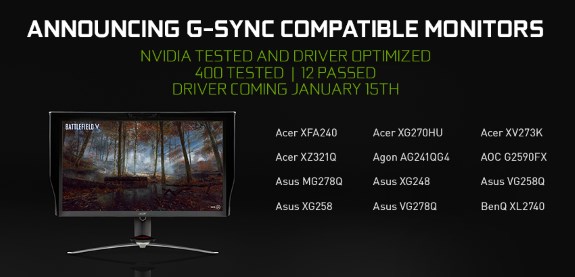
NVIDIA will use a two-tier system. There are hundreds of Adaptive Sync displays but only those that pass NVIDIA's certification test will be validated as G-SYNC compatible. At this point, just 12 of the over 400 screens tested by NVIDIA have passed this test. For G-SYNC compatible screens, Adaptive Sync will be automatically enabled via the GeForce drivers.
For all other screens with Adaptive Sync support, users will have to manually enable the option in the GeForce drives.
Today we’re announcing that we’re expanding the G-SYNC ecosystem.Here's the list of the 12 G-SYNC Compatible displays:
There are hundreds of monitor models available capable of variable refresh rates (VRR) using the VESA DisplayPort Adaptive-Sync protocol. However, the VRR gaming experience can vary widely.
To improve the experience for gamers, NVIDIA will test monitors. Those that pass our validation tests will be G-SYNC Compatible and enabled by default in the GeForce driver.
G-SYNC Compatible tests will identify monitors that deliver a baseline VRR experience on GeForce RTX 20-series and GeForce GTX 10-series graphics cards, and activate their VRR features automatically.
Support for G-SYNC Compatible monitors will begin Jan. 15 with the launch of our first 2019 Game Ready driver. Already, 12 monitors have been validated as G-SYNC Compatible (from the 400 we have tested so far). We’ll continue to test monitors and update our support list. For gamers who have monitors that we have not yet tested, or that have failed validation, we’ll give you an option to manually enable VRR, too.
For the most demanding gamers, G-SYNC and G-SYNC Ultimate HDR displays featuring an NVIDIA G-SYNC processor will represent the very highest image quality, performance and experience. These displays will benefit from an end-to-end certification process that includes more than 300 tests for image quality.
They’ll feature a full refresh rate range from 1 Hz to the display panel’s maximum rate, plus other advantages like variable overdrive, refresh rate overclocking, ultra-low motion blur display modes and industry-leading HDR with 1,000 nits, full matrix backlight and DCI-P3 color.
